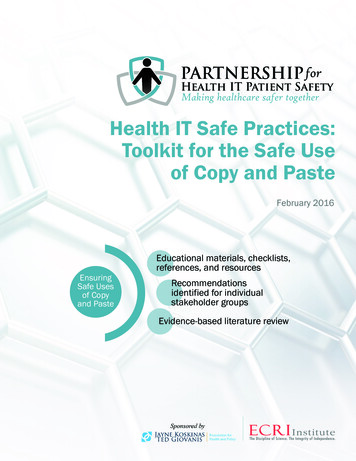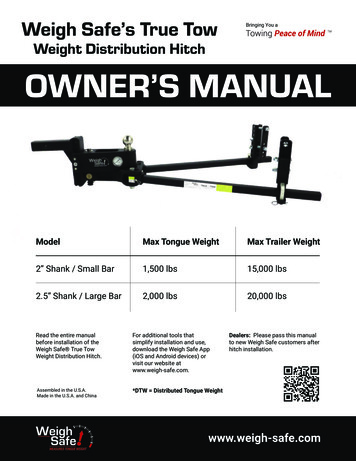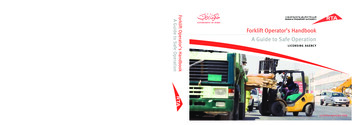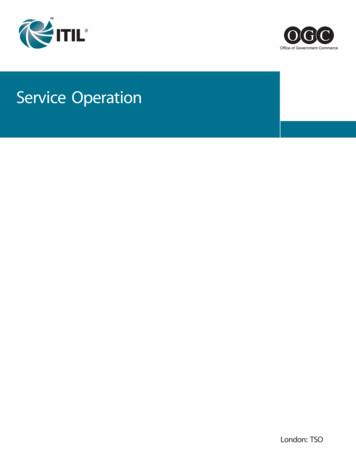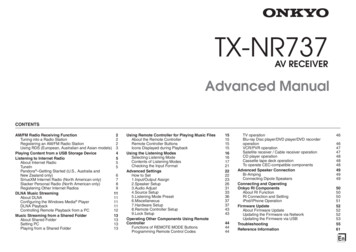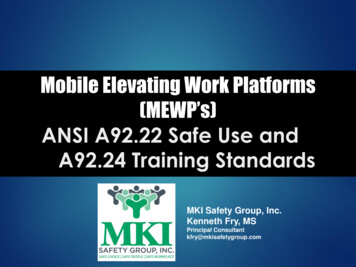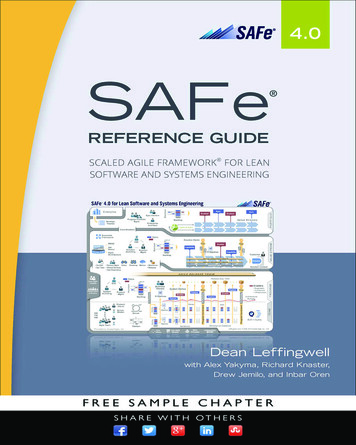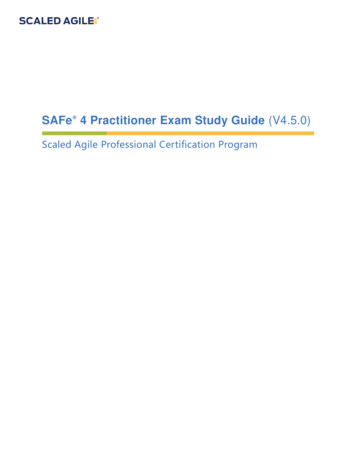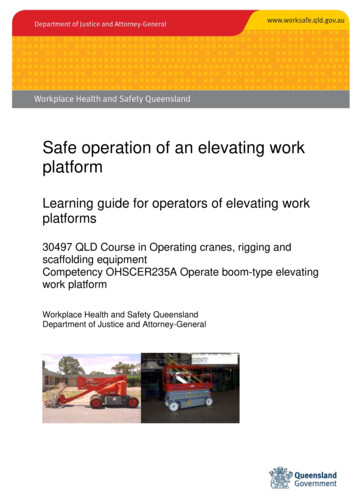
Transcription
Safe operation of an elevating workplatformLearning guide for operators of elevating workplatforms30497 QLD Course in Operating cranes, rigging andscaffolding equipmentCompetency OHSCER235A Operate boom-type elevatingwork platformWorkplace Health and Safety QueenslandDepartment of Justice and Attorney-General
The State of Queensland (Department of Justice and Attorney-General) 2009Disclaimer:Copyright protects this document. The State of Queensland has no objection to this material beingreproduced, but asserts its right to be recognised as author of the original material and the right to have thematerial unaltered.The material presented in this publication is distributed by the Queensland Government as an informationsource only. The State of Queensland makes no statements, representations, or warranties about theaccuracy or completeness of the information contained in this publication, and the reader should not rely onit. The Queensland Government disclaims all responsibility and all liability (including, without limitation,liability in negligence) for all expenses, losses, damages and costs you might incur as a result of theinformation being inaccurate or incomplete in any way, and for any reason.Workplace Health and Safety Queensland, Department of Justice2and Attorney-GeneralSafe operation of an elevating work platform – Learning guide for operators of elevating work platformsPN10042 Version 1. Last updated 24 April 2009Page 2 of 67
ContentsContents . 3About this learning guide . 4Introduction . 5Chapter 1: Responsibility for workplace health and safety . 6Only lift loads that are within the load rating of your machine. 7Chapter 2: Getting to know your elevating work platform . 9Types of elevating work platforms (EWP) . 14Chapter 3: Checking the equipment and work area and planning the job . 18Introduction . 18Types of safety observer. 32Chapter 4: Operation of the elevating work platform . 50Introduction . 50Moving the EWP . 51After moving the EWP. 52Other operational issues . 52Emergency procedures . 54Emergency Descent Device procedures. 55Chapter 5: Shutting down the equipment and securing the site . 56Chapter 6: Getting a certificate of competency. 59Appendix A: Abbreviations. 64Appendix B: Contact details for OHS agencies . 653 and Attorney-GeneralWorkplace Health and Safety Queensland, Department of JusticeSafe operation of an elevating work platform – Learning guide for operators of elevating work platformsPN10042 Version 1. Last updated 24 April 2009Page 3 of 67
About this learning guideThis learning guide is divided into six chapters. Each chapter covers the basic things thattrainees, supervisors and employers need to know for the safe operation of elevating workplatforms.Chapter 1: Responsibility for workplace health and safetyThis chapter contains some important background information about legal requirements foremployers and employees.Chapter 2: Getting to know your elevating work platformThis chapter introduces the equipment and terminology used for typical elevating workplatforms.Chapter 3: Checking the equipment and work area and planning the jobChapter 4: Operating an elevating work platformChapter 5: Shutting down the equipment and securing the siteThese chapters cover the ‘competencies’ (knowledge and skills) that are needed for the safeoperation of an elevating work platform. Each chapter takes a systematic, staged approach,covering the competencies that must be demonstrated in planning your work, doing the workand completing the work.Chapter 6: Getting a licenceThis chapter provides an overview of what you need to do to get a certificate, where to startand who is involved.Appendix A: AbbreviationsAppendix B: Contacts details for OHS agenciesThese appendices provide a handy reference list for abbreviations used in this LearningGuide and contact details for State and Territory occupational health and safety (OHS)jurisdictions.4 and Attorney-GeneralWorkplace Health and Safety Queensland, Department of JusticeSafe operation of an elevating work platform – Learning guide for operators of elevating work platformsPN10042 Version 1. Last updated 24 April 2009Page 4 of 67
IntroductionThis learning guide has been developed to help people gain the knowledge and skills(‘competencies’) needed to operate an elevating work platform (EWP).The ‘competency’ elements in this guide are taken from the National Occupational Healthand Safety Certification Standard for Users and Operators of Industrial Equipment(NOHSC:1006 (2001).This national certification standard is part of a national certification system for users andoperators of industrial equipment, and provides a framework for key learning objectives thatare set out in this guide.All Australian states and territories have legal requirements for operators of boom-typeelevating work platforms to hold a certificate of competency to operate this type ofequipment. If boom length of less than 11 metres usually no licence required.You will find information on how to obtain a certificate of competency in Chapter 6.This learning guide focuses on the competencies required to operate an EWP.It does not deal with the operation of scissor lift platforms or other types of overhead workplatforms for which operators are not required to hold a certificate of competency.This learning guide focuses on EWPs, so all references in this guide are to these types ofmachines.5 and Attorney-GeneralWorkplace Health and Safety Queensland, Department of JusticeSafe operation of an elevating work platform – Learning guide for operators of elevating work platformsPN10042 Version 1. Last updated 24 April 2009Page 5 of 67
Chapter 1: Responsibility for workplace healthand safetyWorkplace health and safety: legal requirementsThere are laws in all Australian states and territories to protect people against the risk ofbeing injured or made ill because of the work they do.In most states and territories these laws are called the Occupational Health and Safety Act orthe Workplace Health and Safety Act.These laws set out who is responsible for safety and what they must do. The responsibleperson has what is called a ‘duty of care’ or obligation.Different people in the workplace have different ‘duties of care’ or obligation.The employer’s duty of care or obligationOccupational health and safety (OHS) laws in Australia are very clear about who has themain responsibility for workplace safety.Employers create the work situations which bring people and work systems, plant,equipment, chemicals and/or other hazards together. Accordingly, employers must takeall reasonable steps to prevent people from being hurt at work.Some of the duties of employers are very broad, such as ‘an employer must ensure thehealth, safety and welfare at work of all employees of the employer’.Others duties are quite specific, such as ‘ensuring that any plant or substance provided foruse by the employees at work is safe and without risks to health when properly used’.The OHS laws say an employer must ensure the safety of its employees in whatever tasksthey undertake on behalf of the employer. This includes the operation of plant and equipmentsuch as elevating work platforms.The employer’s duty of care includes a requirement to ensure that everyone who operates anelevating work platform is qualified to do so (i.e. has a certificate), but it does not end there.The employer is also required to make sure everyone who operates an elevating workplatform has all of the necessary information, training and instruction to operate the elevatingwork platform in all of the work situations which may arise.When you obtain your elevating work platform certificate, this certificate will simply be astatement that you have met the minimum ‘competencies’ required for safe operation. It willnot remove your employer’s duty to ensure that the work you do with the elevating workplatform can be, and is, done safely. This means your employer must provide youwith reasonable training and appropriate instruction and supervision even after you get yourelevating work platform certificate.In addition to having a duty of care for all employees, your employer is also responsible forthe health and safety of other people in the workplace, including visitors, customers,6 and Attorney-GeneralWorkplace Health and Safety Queensland, Department of JusticeSafe operation of an elevating work platform – Learning guide for operators of elevating work platformsPN10042 Version 1. Last updated 24 April 2009Page 6 of 67
contractors and casual workers. You need to be aware of this and understand theprocedures used in your workplace to ensure the safety of others in the workplace.You can see that the ‘duty of care’ obligations on employers are quite substantial and theymust be diligent about safety in the workplace.But this does not mean that you have no responsibilities. You do.Your duty of care / obligation to your employer and othersYou have a duty to take reasonable care for the health and safety of people who are at theemployer’s place of work.You must also co-operate with your employer and anyone else at the workplace in order toenable your employer to meet his or her duties under the OHS laws.The following is typical of the processes you may be required to do: Listen carefully to your employer’s instructions. Know what you need to do and how youshould do it. Follow the safety procedures applying at your workplace. Report any hazardous situations to your supervisor or employer. Advise your safety representative/supervisor or employer if there are any gaps in thesafety procedures. Report any damage to equipment or plant to your supervisor. Tell your supervisor about any maintenance or repairs that need to be carried out on theequipment you are using and tag accordingly. Be aware of others in the workplace and co-operate with other work activities. Use the elevating work platform in a manner that does not endanger others in theworkplace.Only lift loads that are within the load rating of yourmachineYou always need to be mindful of other work activities that may be taking place in your workarea.You have a duty to co-operate with others about how work is to be conducted and, at times,the order in which work is to be done. You may need to consult with other workers, plan yourwork activity and work co-operatively with other workers to make sure that the tasks arecompleted safely.Elevating work platforms are potentially very hazardous items of plant. They move aroundworkplaces in areas where people are also moving about. This combination can createhazardous situations. You must always be aware of these hazards and make sure you do notoperate the elevating work platform in a manner that puts yourself or others at risk.Careless and reckless operation of an elevating work platform is a very serious matter. Itmay result in disciplinary action by your employer, as well as action by the authorities in yourstate or territory.So be aware of the dangers, and always operate your equipment carefully and safely.7 and Attorney-GeneralWorkplace Health and Safety Queensland, Department of JusticeSafe operation of an elevating work platform – Learning guide for operators of elevating work platformsPN10042 Version 1. Last updated 24 April 2009Page 7 of 67
The duties of care of designers, suppliers and manufacturersOHS laws in Australia also establish duties of care for designers, manufacturers andsuppliers (including hirers) of plant, equipment and substances.If you identify a design problem with the equipment you use, bring it to your employer’sattention. Your employer can then take the matter up with the supplier or manufacturer, asthey have an obligation to make sure that the equipment will not expose people to undue riskwhen used in accordance with the instructions.Consultation in the workplaceAn important feature about safety at work is the need for employers to consult withemployees about the work they do. In some states and territories there are legalrequirements for formal consultation mechanisms.You may find that your workplace has a workplace health and safety committee or OHSrepresentatives. The purpose of the committee and representatives is to allow health andsafety issues to be meaningfully discussed and acted upon.The process of consultation should allow people in the workplace to have a real say inmatters that may affect their health and safety.Employers should ensure there are established mechanisms for employees to be consultedabout any hazards that may be present in the workplace and how these can best becontrolled.Similarly, employees need to have a say in the type of equipment or substances brought intothe workplace.The process of consultation also provides you with the opportunity to meet your OHSobligations and contribute to the safety of the workplace.Make the most of your chance to have your say, by making your suggestions helpfuland worthwhile.8 and Attorney-GeneralWorkplace Health and Safety Queensland, Department of JusticeSafe operation of an elevating work platform – Learning guide for operators of elevating work platformsPN10042 Version 1. Last updated 24 April 2009Page 8 of 67
Chapter 2: Getting to know your elevatingwork platformIntroductionThis chapter describes a typical elevating work platform and explains a number of generalterms associated with elevating work platforms.For the purposes of this learning guide an elevating work platform (EWP) is defined as:‘A telescoping device, hinged device or articulated device, or any combination of thesedevices, which is used to support a platform on which personnel, equipment and materialscan be elevated to perform work.’Keep in mind that there are many different models and types of elevating work platforms.This chapter does not attempt to list every type.Key learning areasThe main things you will learn in this chapter are:Parts of an elevating work platformYou will become familiar with the different components of an elevating work platform.Types of elevating work platformsYou will become familiar with the different types of elevating work platforms.Typical elevating work platformsHow to use these diagrams Familiarise yourself with the key parts of the type of elevating work platform on which youare being trained. Refer back to these diagrams as the various parts of an elevating work platform arereferred to in this guide.9 and Attorney-GeneralWorkplace Health and Safety Queensland, Department of JusticeSafe operation of an elevating work platform – Learning guide for operators of elevating work platformsPN10042 Version 1. Last updated 24 April 2009Page 9 of 67
Parts of an elevating work platformFigure 2.1: Typical EWP with telescoping boomFigure 2.2:Typical EWP with telescoping knuckle boom10 and Attorney-GeneralWorkplace Health and Safety Queensland, Department of JusticeSafe operation of an elevating work platform – Learning guide for operators of elevating work platformsPN10042 Version 1. Last updated 24 April 2009Page 10 of 67
Figure 2.3a: Examples of base controls11 and Attorney-GeneralWorkplace Health and Safety Queensland, Department of JusticeSafe operation of an elevating work platform – Learning guide for operators of elevating work platformsPN10042 Version 1. Last updated 24 April 2009Page 11 of 67
Figure 2.3b: Examples of remote and basket controlsObserver and basket remote controls12 and Attorney-GeneralWorkplace Health and Safety Queensland, Department of JusticeSafe operation of an elevating work platform – Learning guide for operators of elevating work platformsPN10042 Version 1. Last updated 24 April 2009Page 12 of 67
Scissor lift single joy stick controlFigure 2.3c: Examples of basket and stabiliser controlsBasket joy stick controls with deadman pedal13 and Attorney-GeneralWorkplace Health and Safety Queensland, Department of JusticeSafe operation of an elevating work platform – Learning guide for operators of elevating work platformsPN10042 Version 1. Last updated 24 April 2009Page 13 of 67
Stabiliser controlsHydraulic basket controlsTypes of elevating work platforms (EWP)Trailer mounted EWPThese elevating work platforms are mounted on a moveable trailer and can be towed bymost vehicles with a tow ball. They have manually adjusted stabilisers to provide stability forthe platform while it is being used and have a range of working heights up to 26 metres.Figure 2.4:Trailer mounted EWP14 and Attorney-GeneralWorkplace Health and Safety Queensland, Department of JusticeSafe operation of an elevating work platform – Learning guide for operators of elevating work platformsPN10042 Version 1. Last updated 24 April 2009Page 14 of 67
Self-propelled EWP with scissor armsThese EWPs are self-propelled units for use on flat concrete surfaces or firm unsealedareas.The work platform is elevated by scissor arms which are powered by hydraulic cylinder(s).There are controls at ground level and on the platform.These EWPs can be fitted with outriggers, and their maximum platform heights can be over30 metres.Note: Licensing for this type of EWP is not required under the National Standard for ‘PersonsPerforming High Risk Work’ [NOHSC:1017 (2006)]Figure 2.5:Self-propelled EWP with scissor armsSelf-propelled EWP with telescoping boomThese EWPs are self-propelled units for use on flat slabs or firm unsealed areas.The work platform is elevated using a straight extension (telescoping) boom. There arecontrols are at ground level and on the platform.15 and Attorney-GeneralWorkplace Health and Safety Queensland, Department of JusticeSafe operation of an elevating work platform – Learning guide for operators of elevating work platformsPN10042 Version 1. Last updated 24 April 2009Page 15 of 67
Figure 2.6:Self-propelled EWP with telescoping boomSelf-propelled EWP with telescoping knuckle boomThese EWPs are self-propelled units for use on flat slabs or firm unsealed areas.The work platform is elevated by a boom which has at least two main sections, with aknuckle between them, and is mounted on a turret which allows slewing. This arrangementpermits the boom to reach up and over obstacles.Both sections of the boom may incorporate a telescoping extension. There are controls atground level and on the platform.Figure 2.7: Self-propelled EWP with a telescoping knuckle boomVehicle-mounted EWPThese EWPs are usually road-registered trucks with a boom or knuckle boom mounted onthe truck chassis.The boom is mounted on a turret to allow slewing, and outriggers are fitted to the chassis.There are controls at ground level and on the platform.16 and Attorney-GeneralWorkplace Health and Safety Queensland, Department of JusticeSafe operation of an elevating work platform – Learning guide for operators of elevating work platformsPN10042 Version 1. Last updated 24 April 2009Page 16 of 67
Figure 2.8:Vehicle-mounted EWP17 and Attorney-GeneralWorkplace Health and Safety Queensland, Department of JusticeSafe operation of an elevating work platform – Learning guide for operators of elevating work platformsPN10042 Version 1. Last updated 24 April 2009Page 17 of 67
Chapter 3: Checking the equipment and workarea and planning the jobIntroductionThis chapter deals with what you need to do before you start operating an EWP.It explains how you need to check the equipment and the worksite to make sure the machineis safe and hazards in the workplace are identified and suitably controlled.It is very important for these checks to become part of your routine, something you naturallydo before you start the job.It is also vital to follow a set procedure in your preparations for work with an EWP,addressing all your work tasks in a systematic and orderly way.An important part of this job planning is to prepare an operational plan for the EWP, verysimply setting out the steps to be followed in the work process.While it may not be compulsory to have an operational plan, it is often a good idea to writedown your plan.This way, you will make sure that you and others in the workplace know what you are goingto do and when you will do it.An operational plan also provides the basis for a work method statement, which will berequired in some work situations.Key learning areasThe main things you will learn in this chapter are:Inspection of the work siteYou will learn processes for planning your work, identifying hazards in your workplace andmaking sure there are appropriate control measures to prevent people getting injured.Pre-operational checksYou will learn about the routine checks of the elevating work platform you need to carry outbefore you even start the motor.Set up proceduresYou will learn how to set up the machine and check that it will safely do the job required.The ‘work steps’ in an operational planThe ‘work steps’ in an EWP operational plan are likely to include those listed below.Each of these work steps is discussed in this chapter.18 and Attorney-GeneralWorkplace Health and Safety Queensland, Department of JusticeSafe operation of an elevating work platform – Learning guide for operators of elevating work platformsPN10042 Version 1. Last updated 24 April 2009Page 18 of 67
Work stepJob requirementsExplanationFinding out what the job involves.PrioritiesDetermining the best order in which to carryout the different tasks you have to perform.Finding out about any particular rules andrequirements of the workplace.Identifying anything on the site that couldcause harm and deciding what you need to doabout each of these hazards.Working with others and ensuring everyone isconsulted and informed about the work to bedone.Workplace rules and proceduresIdentifying hazards and controlmeasuresWorkplace consultationFinding out the job’s requirementsKnowing the requirements of each job is fundamental to carrying out the work safely.There should be a clearly written work specification detailing the type of work to beconducted and the expected results.Among other things, determining the job’s requirements will help you in selecting the rightmachine and working out how many people will be needed for the job.For example, it is important to know the height of the work to be undertaken and the tasks tobe performed at this height. Checking this out before the work starts can save a lot of timeand effort.The key elements to consider when you are working out what the job involves are: the type of work to be done the location of the job, including site and environmental issues and other work activities inthe area the height of the job whether any approvals are required the time within which the job is to be completed, and the expected results or ‘outcomes’.It is best to make a visual inspection of the site as part of your pre-operational planningchecks, if this is possible.If you or your employer cannot visit the site, you should try to gather as much informationabout the site before you agree to undertake the work.This may involve asking a set of standard questions, developed by your employer, beforeyou agree to do the job. These questions should address the matters listed above.You also need to be aware of any special operating requirements, such as whether you willhave to operate the EWP near power-lines, on a suspended floor or above staff facilities andwhether solvents or other chemicals will be used on the work platform. (Responses to thesespecial hazards are addressed later in this chapter and in Chapter 4.)Establishing work prioritiesIf the work you have to do involves a number of tasks, it is important to establish the order inwhich these tasks will be undertaken.19 and Attorney-GeneralWorkplace Health and Safety Queensland, Department of JusticeSafe operation of an elevating work platform – Learning guide for operators of elevating work platformsPN10042 Version 1. Last updated 24 April 2009Page 19 of 67
Often the nature of the work will determine the priority of the tasks. For example, you mayneed to complete tasks at the greatest height first and then complete other tasks atprogressively lower elevations.Your work plan should clearly set out the order in which you will do the required work.Finding out about all relevant workplace rules and proceduresAll workplace rules and procedures must be observed.It is essential to consult with relevant workplace personnel to establish what the rules andprocedures are at each particular site or workplace, and then to co-operate with others at theworkplace by following these set procedures.In planning your work you should consider whether you need to consult with: the owners of the building or site government authorities local councils the site manager supervisors, and other trades.Consider the particular regulatory requirements that may apply to the type of work beingundertaken from the EWP.It is also helpful to speak with the site foreman/safety officer or the person responsible for thework program.Some of the workplace procedures will be statutory requirements, e.g. the need to hold acertificate of competency.Other important procedures are likely to include a need to undertake site induction training ifthe work is to be conducted on a construction site.You should check with the occupational health and safety (OHS) authority in your state orterritory (see Appendix B) to confirm local requirements.Workplace procedures often require operators to wear appropriate personal protectiveequipment (PPE).The type of safety equipment that should be worn at all times by a person working from anelevating work platform includes: a safety harness (a full body harness with an energy-absorbing lanyard) a safety helmet/hard hat steel capped, rubber soled shoes a safety vest, and goggles.Other PPE may also be required, depending on the nature of the work (e.g. a respirator,gloves, ear-muffs for hearing protection, sun screen and/or safety clothing).First aidYou should locate and identify the first-aid kit and/or station that is available before startingwork on any site. This is normally done during the site induction.20 and Attorney-GeneralWorkplace Health and Safety Queensland, Department of JusticeSafe operation of an elevating work platform – Learning guide for operators of elevating work platformsPN10042 Version 1. Last updated 24 April 2009Page 20 of 67
Managing risk in the workplaceElevating work platforms are used in many situations that present unique hazards to theoperator and others, including power-lines, trees and surrounding buildings.You need to be aware of all the potential hazards on the site and make sure all necessarymeasures are taken to control the risks and prevent the hazards from causing any harm.The processes described below are known as ‘risk management’, but as you will see there isnothing particularly difficult about what this means.As explained in Chapter 1 of this learning guide, your employer must make sure yourworkplace is safe and there are adequate controls to prevent accidents and injuries.You can help your employer to manage safety in the workplace through these three simplesteps.IDENTIFY all potential hazardsWhat does this mean?There is a need to take a risk assessment of the area and look out for hazards or potentialhazards that may cause a problem or endanger you or others.How do you do this?The easiest way is to walk around the work area, looking for anything that could be aproblem (e.g. an open pit in the work area, power lines etc).ASSESS the risksWhat does this mean?This means that you work out which things are the most serious.How do you do this?Ask yourself how seriously things in your work area might hurt or injure people and how likelyit is to happen.By doing this you work out which things you need to deal with first, especially if something isvery dangerous and could seriously hurt people.For example, an open pit would pose a serious risk to anyone on an EWP working nearby.CONTROL the risksWhat does this mean?This is the action that must be taken to prevent people from getting hurt.How do you do this?It depends on the risk and the circumstances.In the case of the open pit example, barricades would need to be placed around the pit toprevent unintended access to
When you obtain your elevating work platform certificate, this certificate will simply be a statement that you have met the minimum 'competencies' required for safe operation.

